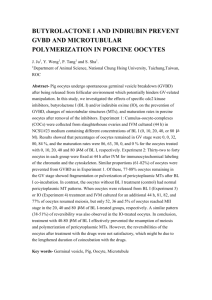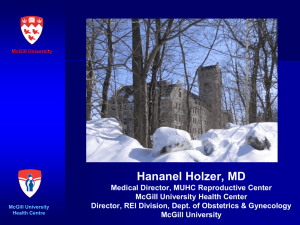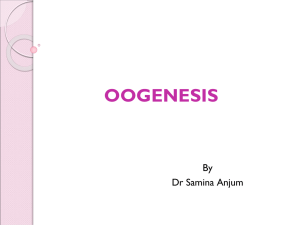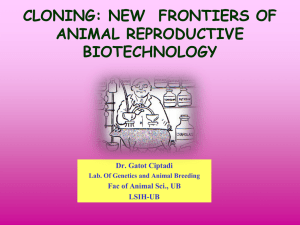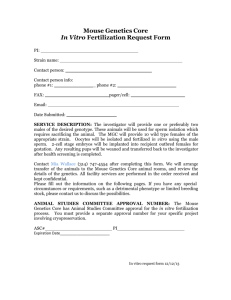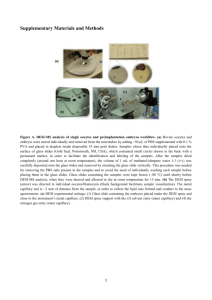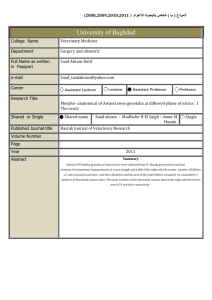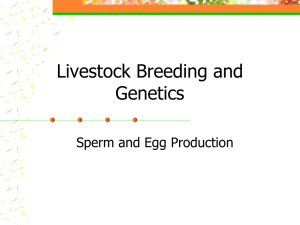Onderzoeksverslag - Ellen Vasse (1)
advertisement
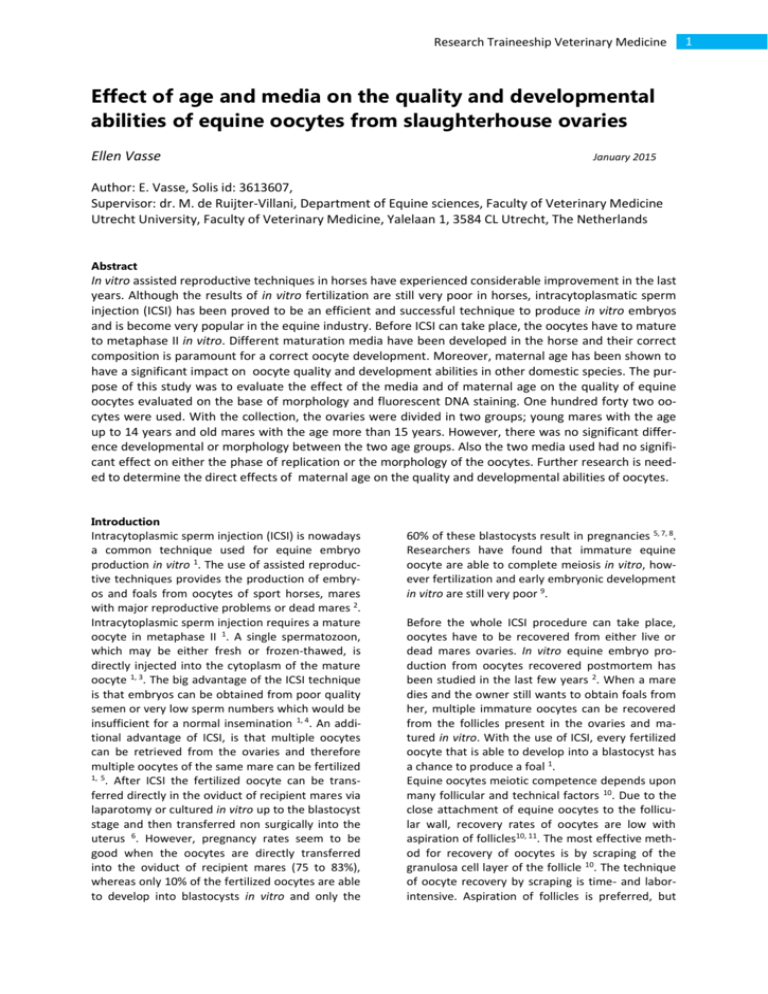
Research Traineeship Veterinary Medicine Effect of age and media on the quality and developmental abilities of equine oocytes from slaughterhouse ovaries Ellen Vasse January 2015 Author: E. Vasse, Solis id: 3613607, Supervisor: dr. M. de Ruijter-Villani, Department of Equine sciences, Faculty of Veterinary Medicine Utrecht University, Faculty of Veterinary Medicine, Yalelaan 1, 3584 CL Utrecht, The Netherlands Abstract In vitro assisted reproductive techniques in horses have experienced considerable improvement in the last years. Although the results of in vitro fertilization are still very poor in horses, intracytoplasmatic sperm injection (ICSI) has been proved to be an efficient and successful technique to produce in vitro embryos and is become very popular in the equine industry. Before ICSI can take place, the oocytes have to mature to metaphase II in vitro. Different maturation media have been developed in the horse and their correct composition is paramount for a correct oocyte development. Moreover, maternal age has been shown to have a significant impact on oocyte quality and development abilities in other domestic species. The purpose of this study was to evaluate the effect of the media and of maternal age on the quality of equine oocytes evaluated on the base of morphology and fluorescent DNA staining. One hundred forty two oocytes were used. With the collection, the ovaries were divided in two groups; young mares with the age up to 14 years and old mares with the age more than 15 years. However, there was no significant difference developmental or morphology between the two age groups. Also the two media used had no significant effect on either the phase of replication or the morphology of the oocytes. Further research is needed to determine the direct effects of maternal age on the quality and developmental abilities of oocytes. Introduction Intracytoplasmic sperm injection (ICSI) is nowadays a common technique used for equine embryo production in vitro 1. The use of assisted reproductive techniques provides the production of embryos and foals from oocytes of sport horses, mares with major reproductive problems or dead mares 2. Intracytoplasmic sperm injection requires a mature oocyte in metaphase II 1. A single spermatozoon, which may be either fresh or frozen-thawed, is directly injected into the cytoplasm of the mature oocyte 1, 3. The big advantage of the ICSI technique is that embryos can be obtained from poor quality semen or very low sperm numbers which would be insufficient for a normal insemination 1, 4. An additional advantage of ICSI, is that multiple oocytes can be retrieved from the ovaries and therefore multiple oocytes of the same mare can be fertilized 1, 5 . After ICSI the fertilized oocyte can be transferred directly in the oviduct of recipient mares via laparotomy or cultured in vitro up to the blastocyst stage and then transferred non surgically into the uterus 6. However, pregnancy rates seem to be good when the oocytes are directly transferred into the oviduct of recipient mares (75 to 83%), whereas only 10% of the fertilized oocytes are able to develop into blastocysts in vitro and only the 60% of these blastocysts result in pregnancies 5, 7, 8. Researchers have found that immature equine oocyte are able to complete meiosis in vitro, however fertilization and early embryonic development in vitro are still very poor 9. Before the whole ICSI procedure can take place, oocytes have to be recovered from either live or dead mares ovaries. In vitro equine embryo production from oocytes recovered postmortem has been studied in the last few years 2. When a mare dies and the owner still wants to obtain foals from her, multiple immature oocytes can be recovered from the follicles present in the ovaries and matured in vitro. With the use of ICSI, every fertilized oocyte that is able to develop into a blastocyst has a chance to produce a foal 1. Equine oocytes meiotic competence depends upon many follicular and technical factors 10. Due to the close attachment of equine oocytes to the follicular wall, recovery rates of oocytes are low with aspiration of follicles10, 11. The most effective method for recovery of oocytes is by scraping of the granulosa cell layer of the follicle 10. The technique of oocyte recovery by scraping is time- and laborintensive. Aspiration of follicles is preferred, but 1 Research Traineeship Veterinary Medicine recovery rates may be only the half in comparison with recovery rates by scraping 11. Some laboratories have a strict selection of oocytes before maturation, for example in cattle only the compact cumulus oocytes complex oocytes (Cp oocytes) are selected to undergo ICSI procedure. Cp oocytes can originate mature follicles, or mainly from immature follicles. In the horse most of those Cp oocyte are not competent enough for in vitro maturation to metaphase II 11. Therefore, a similar selection of equine oocytes would eliminate the majority of meiotic competent oocytes in the mare 10. In the study of Hinrichs et al. (1997) they concluded that expanded cumulus oocyte complex oocytes (Ex oocytes) have a significant higher prevalence to maturate into metaphase I and metaphase II than Cp oocytes 12. Ex oocytes also have a significant lower prevalence of degeneration than CP oocytes and require less time to prepare the germinal vesicle breakdown 12, 13. Maturation of equine oocytes is a complex process, involving several nuclear and cytoplasmic developmental changes. Nuclear maturation of the oocytes includes not only the breakdown of the germinal vesicle, but also the reorganization and segregation of chromosomes. Cytoplasmic maturation requires the accumulation of mRNA, protein, substrates and nutrients, but also the migration of cortical granules is an important step to achieve oocyte developmental competence 14, 15 . Maturation of the oocyte is essential in order to become viable, fertilizable and competent for further development 16. Several different types of media and incubation periods have been evaluated for the maturation of equine oocytes 9. However, maturation to metaphase II have been disappointing in most of the media 16. Not only technical factors have an influence on the meiotic competence of equine oocytes. In most of mammalian species, reproductive success decreases with maternal age 17. Aging induces multifactorial changes in the reproductive system which in turn affect oocyte competence probably through altering their mitochondria functionality 18. Mitochondria are involved in different processes in the oocyte and seem to be particularly prone to suffer oxidative damage since their DNA (mt DNA) is very close to the site of ROS (reactive oxygen species) generation. In a recent study of Rambags et al. (2014) observed that maternal aging was associated with increased susceptibility to mitochondrial damage and loss in equine oocytes during in vitro maturation. In fact, increase in maternal age was accompanied by a decrease in equine oocyte mtDNA quantity after in vitro maturation 17. Other underlying age dependent causes of decreased reproductive success have been proposed. In a study on human oocytes, it was shown that oocytes from old women (40-45 years) showed more abnormalities in chromosome placement in metaphase plates if compared with oocytes from young women (20-25 years). The microtubule organization of these oocytes was either abnormal or disordered. The chromosomes were not tightly aligned, as in the younger women, with one or more chromosomes being considerably displaced from the metaphase plate. During oocyte maturation, there is a link between chromosome placement and the spindle assembly process, which can be dysfunctional in older individuals. Spindle abnormalities may be caused by changing in regulatory factors and/or altered the timing of the phases of meiosis resulting in microtubule irregularities and unusual chromosome placement 19. Similarly to women, also in the equine species chromosomal abnormalities in the oocytes have been proposed as a cause of early embryonic loss, however no information is currently available on the incidence of these abnormalities in horses 20. Moreover the majority of the studies published so far are on mice and there is no information on the effect of age on equine oocyte quality. The aim of the current study is to focus on the effect of age and maturation medium on the quality of equine oocytes from slaughterhouse material, based on oocyte morphology and phase of replication. Material and methods A complete list of all used materials can be found in the appendix 2. Collection of slaughterhouse ovaries All the ovaries were obtained from 39 slaughtered mares aging 2 to 26 years in the months of November and December 2014. The ovaries were divided in two groups; ovaries from young mares (age up to 14 years) and ovaries of old mares (more than 15 years of age). The ovaries were collected in little plastic bags and kept warm in a Perspex box with the use of warming elements. The ovaries were then transported to the Department of Equine Sciences, Section Reproduction and Obstetrics (Faculty of Veterinary Medicine, Utrecht University). First, excess tissue was cut away from the ovaries with scissors. Thereafter the ovaries were rinsed 3 times all at 37 °C with tapwater, 3 times with Ringer lactate (B. Braun Melsungen, Germany) and 3 times with Phosphate Buffered Saline (PBS) (B. Braun Melsungen, Germany). Cumulus oocyte complexes (COC) were collected by puncturing the follicles with a scalpelblade No. 11 (Swann-Morton, 2 Research Traineeship Veterinary Medicine United Kingdom), above a 9 cm petridish filled with 3 ml Euroflush Heparine (Heparine 400 ul/L (5000 IU/ml, LEO Pharma BV, Denmark) and Euroflush, IVM Technologies, The Netherlands) so the follicular fluid dripped into the petridish. With bone curettes, ranging from 2 to 10 mm, we scraped the inside of the follicle out and the follicular cavity was flushed 2 times with PBS. The number of punctured follicles was registered. Group 4: IVM medium with Fetal Calf Serum, old oocytes. All oocytes were incubated for 24 to 36 hours at 38,5ᵒC with 5% CO2 and 5% O2 in 5 ml tubes containing 500 µl IVM medium and a maximum of 25 oocytes per tube. The time between slaughter end the beginning of culture was about 4 to 5 hours. Denudation of oocytes After approximately 24 hours of maturation, the oocytes and their cumulus cells were transferred into a 3 cm petridish containing 1:100 dilution of hyaluronidase (Sigma, USA) in H-SOF medium (Avantea, Italy). The cumulus cells were partially dislodged pipetting the oocyte up and down. The oocytes were then transferred with a mouth pipet containing an Bogger glass capilairy pipette to HSOF (Aventea, Italy) with 1:100 dilution of trypsin (Sigma, USA) and incubated for 1,30 min. Then the oocytes were transferred them into the H-SOF (Avantea, Italie ) with 10%FCS (Gibco, the Netherlands) to inactivate trypsin and pipettetted up and down to remove all the cumulus cells. We tried to remove the cumulus cells and after denudation the oocytes were collected in H-SOF (Aventea, Italy). Throughout the whole process, the groups (young and old) were separated from each other. Collection of oocytes The follicular fluid collected was evaluated under the microscope either directly or after filtration and the oocyte collected and washed in H-medium. All petridishes and media used in all manipulation were preheated at 37 °C. Between the manipulation steps, we washed the petridishes with Euroflush to be sure there were no oocytes left. Maturation of oocytes The oocytes (n=170) recovered were washed 4 times in H-SOF. After the washing steps, the oocytes are matured in vitro to reach metaphase II. Two different in vitro maturation (IVM) media were used. The first medium (“SR” medium) contained Dulbecco’s Modified Eagle Medium (DMEM) 3,6 ml (Gibco, The Netherlands), Serum Replacement 400 µl (Gibco, The Netherlands), Human Epidermal Growth Factor (EGF) 4 µl (Peprotech, USA), Cysteine+Cysteamine 40 µl ( Sigma, USA), Lactate solution 40 µl (Sigma, USA), Insuline, Transferin, Selenite (ITS) 4 µl (VWR International BV, the Netherlands), Follicle Stimulating Hormone (FSH) 4 µl (Sigma, USA). The second medium (“FCS”medium) contained instead of 400 µl SR, 400 µl of Fetal Calf Serum (FCS) (Gibco, the Netherlands). Eighty two oocytes were matured in the serum replacement medium (39 young and 43 old) and 88 in the FCS medium (33 young and 55 old). Group 1: IVM medium with Serum Replacement, young oocytes. Group 2: IVM medium with Fetal Calf Serum, young oocytes. Group 3: IVM medium with Serum Replacement, old oocytes. Fixation and staining of oocytes The oocytes were fixed in 4% paraformaldehyde (PFA) (Klinipath BV, The Netherlands) for 1 hour at room temperature and then transferred in 1% PFA solution and stored at 5°C until staining. All oocytes were then washed with PBS+PVP 3mg/ml (Sigma, USA) 3 times for 5 minutes. We then stained the 4 groups of oocytes in 0.1 µg/ml of the non-toxic, fluorescent membrane-impermeable DNA stain 4’,6-diamidino-2-phenylindole dihydrochloride (DAPI) (Molecular Probes Europe BV, The Netherlands) in PBS at room temperature for 15 min in the dark. After the staining, we mounted the oocytes on a glass slide (Superfrost Plus, Menzel, Braunschweig, Collection date Age (young + old) n. ovaries mares n. follicles n. oocytes Percentage1 05-11-2014 Young 8 112 68 60,7% Old 9 112 72 64,3% Young 6 53 46 86,8% Old 8 54 30 55,6% Young 11 56 39 69,0% Old 12 166 82 49,0% 19-11-2014 27-11-2014 Table 1. Collection of equine ovaries. Total amount of scraped follicles and collected oocytes. 1 Percentages based on number of oocytes collected out of number of follicles 3 Research Traineeship Veterinary Medicine 4 Germany) with a maximum of 7 oocytes per slide using Vectashield (10ul) (Vector Laboratories, Burlingame, CA) mounting media. To avoid excessive pressure, Vaseline was used as spacer between the microscope slide and the cover slip. The coverslip was then sealed with fingernail polish. Microscopic analysis of morphology and stained oocytes All oocytes were assessed for morphology and nuclear maturation under the microscope. For the microscopic assessment of the DNA staining of the oocytes, we used a fluorescence microscope (Type: BH-2-RFCA, Olympus, Japan) with x10 and x20 magnifications for the detection of the DNA. We used the same microscope for the analysis of the morphology of the oocytes. We made pictures of all stained oocytes with a Canon E-330 camera. The images were subsequently stored digitally. Analytical criteria We used our own analytical criteria for morphology and nuclear maturation as Figure 1. Equine oocyte after DNA staining with fluorescence microscope (10-20x) A: Germinal vesicle breakdown, B: Metaphase I C: Anaphase II, D: Metaphase II follows. For the morphology, we used 5 groups; (A) Oocyte with a round shape, (m) and the first polar body (pb), E: Degenerated, F: Not analyzable due to many homogeneous cytoplasm and a polar cumulus cells. * cumulus cells body could be shown, (B) Oocyte with not a full (C) metaphase II, (D) fragmented or degenerated round shape, homogeneous cytoplasm, (C) Oocyte and (E) not analyzable (Figure 2). We had classified with not a full round shape, not fully homogeneous all the 142 cytoplasm, some artefacts could be shown, (D) Oocyte with an abnormal shape, abnormal cytooocytes by this analytical criteria. All observation plasm, could be degenerated or fragmented and were performed by the same investigator. (E) Oocyte is not analyzable due to many cumulus cells or artefacts (Figure 1). Statistical analysis We have chosen these analytical criteria on the Data were analyzed using SPSS Statistics Data Edibase of previous observations that heterogeneous tor 22.0.0.0 (SPSS Inc., Chicago, IL, USA). The effect cytoplasm is associated with a high meiotic compeof the maternal age and media were compared tence in equine oocytes. This appearance of cytowith the quality and developmental abilities of the plasm is frequently seen in Ex oocytes. For Cp oooocytes, based on the morphology and phase of cytes, most of the oocytes have a homogeneous replication. We analyzed the 4 different groups (SR cytoplasm and are associated with a reduced meiwith young oocytes, FCS with young oocytes, SR otic compwith old oocytes, FCS with old oocytes) with an etence 11. independent students T Test to analyze the signification. Differences between groups were considFor the DNA staining we used first 6 groups; (A) ered statistically significant if P was less than 0,05. germinal vesicle stage, (B) metaphase I, (C) anaphase II, (D) metaphase II, (E) fragmented or deResults generated and (F) not analyzable due to lots of Follicle and oocyte numbers cumulus cells or no DNA stained in a cell with a The total rate of oocyte recovery per follicle pronormal morphology. We brought that together to 5 cessed was 60,94% (337 oocytes out of 553 folligroups; (A) germinal vesicle stage, (B) metaphase I, cles). There was a little difference between the Research Traineeship Veterinary Medicine oocyte collection from young (153 out of 221; 69,23%) and old (184 out of 332; 55,42%) mares. Of the 337 oocytes collected, 140 were not included in the present study. In vitro maturation Oocytes matured in FCS appeared to have a more expanded cumulus oocyte complex than the oocyte matured in SR (Figure 3. A and B). Also in the denudation process, the oocytes out of FCS media were more easier to denudate than those out of SR media. Morphology and Staining In total, 142 oocytes (young, SR, n=32; old, SR, n=43; young, FCS, n=23; old, FCS, n=44) were analyzed for morphology and nuclear maturation. Most of the oocytes had a good appearance (40 out of 85; 47% in old mares and 28 out of 55; 51% in young mares) (Figure 1). No significant difference in oocyte morphology after maturation was seen between young and old mares. Although no significant difference in oocyte DNA maturation between the two age group was observed, the percentage of oocytes that matured to metaphase II, was higher in the old group (44 of 51; 85%) compared to the young group (21 of 31; 68%). Unrespective of the groups (age and medium) seventy-eight percent (65/83) of the oocytes examined were in metaphase II. Although there was no significant difference in morphology or oocyte DNA maturation between the two media, oocytes matured in Fetal Calf Serum medium had a slightly better morphology (36 to 67; 54%) than those matured in Serum Replacement medium (32 to 73; 44%). Seventy-two percent (26 of 36) of the oocytes matured in SR medium and 83% (39 of 47) of the oocytes matured in FCS medium reached metaphase II. Discussion The present study describes the effects of the age and media on the quality and the developmental abilities of equine oocytes from slaughterhouse material. IVM Medium In our study, we have matured the equine oocytes in a maturation medium different from other reports. We used an IVM medium based on DMEM, in combination with different supplements (Human EGF, Cysteine and Cysteamine, Lactate solution, ITS, FSH, SR or FCS). Various maturation media have been evaluated to perform the highest maturation rate. Some laboratories employed their medium based on tissue culture medium 199 (TCM199 or M199) 21, others based their medium on B2 or Ham’s F10 8, both in combination with a different concentration of hormones, serum or follicular fluid. For example, supplementation of epidermal growth factor (EGF) has been shown to increase the fertilization rate in pigs 22, but also the nuclear maturation rates in the mare 23. In the study of Pereira et al. (2011), they observed that the maturation rate of the equine oocytes increased when equine growth hormone (eGH) was added into the IVM medium, in combination with IGF-1 21. Maturation rates varies from 20 to 85% in different laboratories, normally approximately 60% of the oocytes mature to metaphase II 8, 11. In 1981, Fulka and Okolski reported the first in vitro maturation of equine oocytes and they observed that 68% of their oocytes reached metaphase II 10. Galli et al. (2007) achieved with the DMEM medium a higher blastocyst development rate in their laboratory (26%) than oocytes matured in modified M199 (12%) 8. However, K. Hinrichs et al. (2013) described that the highest blastocyst rates (42%) in Figure 2. Equine oocyte after in vitro maturation for 24 hours, fluorescence vitro was observed when an IVM medium microscope (10-20x). A and B: round shaped, homogeneous cytoplasm including M199 with Earles salts, 10% Fetal oocytes, C: not a full round shape, homogeneous cytoplasm, D: not a full Bovine Serum (FBS) and 5 mU mL-1 bovine round shape, full homogeneous cytoplasm, E: abnormal shape and cyto- FSH was used and the oocytes/early embryo plasm, could be degenerated or fragmentated, F: Not analyzable due to were incubated in a humidified atmosphere of cumulus cells or artefacts. * cumulus cells < artefact 5% CO2 in air at 38.2 ᵒC 4, 10. Although we did 5 Research Traineeship Veterinary Medicine not have any information on the blastocyst rate, since we did not performed ICSI on our matured oocytes, after in vitro maturation we observed that the 74,7% of the oocytes that reached metaphase II. Both media we used was equally successful in obtaining metaphase II oocytes. In fact there was no difference in the percentage of the oocytes which reached metaphase II in the two media, IVM medium with FCS, 83% (39/47) versus IVM medium with SR 72% (26/36). Age of mares Although it has been previously described that in vitro maturation of the oocytes is characterized by a high susceptibility to mitochondrial damage and loss 17, the results of our study show no significant effect of maternal age on the quality or developmental ability of equine oocytes after in vitro maturation. In a study of Carnevale et al. (2000), they compared the oocyte morphology of young (3-10 years) and old mares (> 19 years), with the use of a light and electron microscopy 24. The oocytes of the old mares appeared to contain large vesicles (>1% volume of the total area oocyte). The mean number of large vesicles per oocytes was greater for the old mares’ oocytes. One oocyte had a vesicle that filled 50% of the ooplasm and one vesicle localized in the nucleus. The oocytes of the old mares also tended to have less cortical granules and larger areas of clustered smooth endoplasmic reticulum surrounded by mitochondria. Other oocytes from aged mares showed atypical shapes, sections of oolemma with sparse microvilli and sections of ooplasm with no organelles. Carnevale et al. (2000) suggested that the increase of vacuolization was caused by the accumulation of damage in the equine oocytes 24-26. More often aged oocytes of human and mouse display changes in spindle assembly and organization. Since only scares data are available on the effect of maternal aging on the oocyte quality, further research is necessary to understand if increase in maternal age in the mare is associated with decrease in oocyte quality. Cumulus expansion Surprisingly, the present study indicates that the oocytes after in vitro maturation in the IVM medium containing Fetal Calf Serum, have a greater expansion of the cumulus cells than the oocytes matured in IVM medium with Serum Replacement. In the study of M.L. Leibfried-Rutlegde et al (1986), they describe that Fetal Calf Serum may be an essential compound for FSH-induced cumulus expansion and cumulus cell viability, and completion of the first meiotic division in hamster and bovine oocytes 27. Whereas, in the study of G. Carneiro et al (2001), they showed that if FCS was absent, IGF-I had a positive effect on the in vitro maturation of the equine oocyte. They suggest that FCS might have an effect on IGF-I interactions or its binding proteins 9. Although, not much is known about the effect of FCS in the IVM medium, further research is needed to confirm the effects of the two different media on the cumulus expansion. A B Figure 3. Equine oocytes after 24 to 36 hours of in vitro maturation. A: Expanded cumulus oocyte complex, matured in IVM medium containing SR, B: Compact cumulus oocyte complex, matured in IVM medium containing FCS. As results of reduced expansion of the cumulus, the denudation process was more difficult in the oocytes matured in media containing SR. In fact, 39 of the in total 75 oocytes (52%) placed in the IVM medium with Serum Replacement, were not analyzable due to the strong attachment of the cumulus cells around the oocyte (Figure 1. F). Conclusion In the current study, based on the morphology and the phase of replication neither the maternal age nor the media had an effect on the developmental abilities and quality of equine oocyte from slaughterhouse material. Although, we saw a difference in the expansion of the cumulus-oocytes-complex between the two different media, we did not record any significant difference in oocyte quality or developmental ability between the two media used. Therefore we concluded that both of our 6 Research Traineeship Veterinary Medicine media could be used to mature equine oocytes to metaphase II. It is possible that with the current methods we underestimated the effect of maternal age on oocyte developmental capacity; in fact a study evaluating the spindle morphology and alignment or the centrometers cohesion could possibly have revealed more subtly effects of aging on the spindle assembly abilities. Therefore further re search is needed to better understand the effect of advanced maternal age on oocyte quality in mares. Acknowledgments The authors is grateful to dr. Marta de Ruijter-Villani and Mabel Beitsma for support and technical assistance and also Marilena Rizzo, Claudia Deelen, Denis Necchi, Anthony Claes and Leni Tol for the processing and scoring of the equine oocytes. The author’s work was supported by the Department of Equine Sciences, Section Reproduction and Obstetrics (Faculty of Veterinary Medicine, Utrecht University). References 1. Hinrichs K. Update on equine ICSI and cloning. Theriogenology 2005;64(3):535-41. 2. Mari G, Barbara M, Eleonora I, Stefano B. Fertility in the mare after repeated transvaginal ultrasound-guided aspirations. Anim Reprod Sci 2005;88(3):299-308. 3. Stout T. Equine embryo transfer: Review of developing potential. Equine Vet J 2006;38(5): 467-78. 4. Hinrichs K. Assisted reproduction techniques in the horse. Reproduction, Fertility and Development 2012;25(1):80-93. 5. Hinrichs K. Application of assisted reproductive technologies (ART) to clinical practice. Proc am assoc equine pract; 2010. 6. Tremoleda JL, Stout TA, Lagutina I, Lazzari G, Bevers MM, Colenbrander B, Galli C. Effects of in vitro production on horse embryo morphology, cytoskeletal characteristics, and blastocyst capsule formation. Biol Reprod 2003 Dec;69(6):1895-906. 7. Hinrichs K, Choi Y, Norris JD, Love LB, BedfordGuaus SJ, Hartman DL, Velez IC. Evaluation of foal production following intracytoplasmic sperm injection and blastocyst culture of oocytes from ovaries collected immediately before euthanasia or after death of mares under field conditions. J Am Vet Med Assoc 2012;241(8):1070-4. 8. Galli C, Colleoni S, Duchi R, Lagutina I, Lazzari G. Developmental competence of equine oocytes and embryos obtained by in vitro procedures ranging from in vitro maturation and ICSI to embryo culture, cryopreservation and somatic cell nuclear transfer. Anim Reprod Sci 2007;98(1):39-55. 9. Carneiro G, Lorenzo P, Pimentel C, Pegoraro L, Bertolini M, Ball B, Anderson G, Liu I. Influence of insulin-like growth factor-I and its interaction with gonadotropins, estradiol, and fetal calf serum on in vitro maturation and parthenogenic development in equine oocytes. Biol Reprod 2001 Sep;65(3):899-905. 10. Hinrichs K. The equine oocyte: Factors affecting meiotic and developmental competence. Mol Reprod Dev 2010;77(8):651-61. 11. Hinrichs K. In vitro production of equine embryos: State of the art. Reproduction in Domestic Animals 2010;45(s2):3-8. 12. Hinrichs K, Williams KA. Relationships among oocyte-cumulus morphology, follicular atresia, initial chromatin configuration, and oocyte meiotic competence in the horse. Biol Reprod 1997 Aug;57(2):377-84. 13. Alm H, Hinrichs K. Effect of cycloheximide on nuclear maturation of horse oocytes and its relation to initial cumulus morphology. J Reprod Fertil 1996 Jul;107(2):215-20. 14. Goudet G, Bezard J, Duchamp G, Gerard N, Palmer E. Equine oocyte competence for nuclear and cytoplasmic in vitro maturation: Effect of follicle size and hormonal environment. Biol Reprod 1997 Aug;57(2):232-45. 15. Watson AJ. Oocyte cytoplasmic maturation: A key mediator of oocyte and embryo developmental competence. J Anim Sci 2007 Mar;85(13 Suppl):E1-3. 16. Tremoleda J, Schoevers E, Stout T, Colenbrander B, Bevers M. Organisation of the cytoskeleton during in vitro maturation of horse oocytes. Mol Reprod Dev 2001;60(2):260-9. 17. Rambags B, van Boxtel D, Tharasanit T, Lenstra J, Colenbrander B, Stout T. Advancing maternal age predisposes to mitochondrial damage and loss during maturation of equine oocytes in vitro. Theriogenology 2014;81(7):959-65. 18. Altermatt J, Suh T, Stokes J, Carnevale E. Effects of age and equine follicle-stimulating hormone (eFSH) on collection and viability of equine oocytes assessed by morphology and developmental competency after intracytoplasmic sperm injection (ICSI). Reproduction, Fertility and Development 2009;21(4):615-23. 19. Battaglia DE, Goodwin P, Klein NA, Soules MR. Influence of maternal age on meiotic spindle 7 Research Traineeship Veterinary Medicine assembly in oocytes from naturally cycling women. Hum Reprod 1996 Oct; 11(10):2217-22. 20. Rambags B, Krijtenburg P, Van Drie H, Lazzari G, Galli C, Pearson P, Colenbrander B, Stout T. Numerical chromosomal abnormalities in equine embryos produced in vivo and in vitro. Mol Reprod Dev 2005;72(1):77-87. 21. Pereira GR, Lorenzo PL, Carneiro GF, Ball BA, Gonçalves PBD, Pegoraro LMC, BilodeauGoeseels S, Kastelic JP, Casey PJ, Liu IK. The effect of growth hormone (GH) and insulinlike growth factor-I (IGF-I) on in vitro maturation of equine oocytes. Zygote 2012; 20(04): 353-60. 22. Hinrichs K, Love CC, Brinsko SP, Choi YH, Varner DD. In vitro fertilization of in vitro-matured equine oocytes: Effect of maturation medium, duration of maturation, and sperm calcium ionophore treatment, and comparison with rates of fertilization in vivo after oviductal transfer. Biol Reprod 2002 Jul; 67(1):256-62. 23. Lorenzo P, Liu I, Carneiro G, Conley A, Enders A. Equine oocyte maturation with epidermal growth factor. Equine Vet J 2002; 34(4):378-82. 24. Carnevale E, Maclellan L, Coutinho da Silva M, Scott T, Squires E. Comparison of culture and insemination techniques for equine oocyte transfer. Theriogenology 2000;54(6):981-7. 25. Carnevale E. The mare model for follicular maturation and reproductive aging in the woman. Theriogenology 2008;69(1):23-30. 26. Madill S. Reproductive considerations: Mare and stallion. Veterinary Clinics of North America: Equine Practice 2002 12; 18(3):591-619. 27. Leibfried-Rutledge ML, Critser ES, First NL. Effects of fetal calf serum and bovine serum albumin on in vitro maturation and fertilization of bovine and hamster cumulus-oocyte complexes. Biol Reprod 1986 Nov;35(4):850-7. 8 Research Traineeship Veterinary Medicine 9 Research Traineeship Veterinary Medicine 10 Appendix 1.0 Experiment 1 Introduction The oocytes mature in an in vitro maturation (IVM) medium to reach metaphase II. Because our equine oocytes didn’t reach metaphase II after 24 to 26 hours in the in vitro maturation medium, we tried to make the in vitro maturation medium differently. We used bovine oocytes for this experiment, because the supply of ovaries from mares out of slaughterhouses and also the number of oocytes are both limited (40). Stated compounds Our medium contains Dulbecco’s Modified Eagle Medium (DMEM) 3,6 ml (Gibco, The Netherlands), Serum Replacement 400 µl (Gibco, The Netherlands), Human epidermal growth factor (EGF) 4 µl (Peprotech, USA), Cysteine+Cysteamine 40 µl ( both Sigma,USA), Lactate solution 40 µl (Sigma, USA), Insuline, Transferin, Selenite (ITS) 4 µl (VWR, the Netherlands), Follicle Stimulating Hormone (FSH) 4 µl (Sigma, USA) ). We incubated the oocytes in the IVM medium for 24 to 26 hours at 38,5°C with 5% CO2 and 5% O2. IVM medium with different compounds Number 1 IVM medium: DMEM 1,8 ml + Human EGF 2 µl + Cysteine+Cysteamine 20 µl + ITS 2 µl + FSH 2 µl + Serum Replacement 200 µl + Lactate solution 20 µl (diluted) Number 2 IVM medium: DMEM 1,8 ml + Human EGF 2 µl + Cysteine+Cysteamine 20 µl + ITS 2 µl + FSH 2 µl + Serum Replacement 200 µl + Lactate 1,88 µl (undiluted) Number 3 IVM medium: DMEM 3,6 ml + Human EGF 4 µl + Cysteine+Cysteamine 40 µl + ITS 4 µl + FSH 4 µl + Fetal Calf Serum 400 µl + Lactate solution 40 µl (diluted) Results The first thing we noticed was the difference of color in the various media. IVM medium with Fetal Calf Serum had a more red color then the other two media and looked more healthy than the other two. The bovine oocytes were able to mature to metaphase II in all of the different media. So our conclusion was that there’s no problem with the medium, but maybe with something else. 3 A 1 2 B Figure. 4 The images show us the colours of the IVM medium. A: Numbers 1, 2 and 3 in tubes, B: 1 and 2 are the upper and 3 underneath in a 4 well plate A B Figure. 5 After 24 hours in the IVM medium, bovine oocytes (10-20x) A: Bovine oocyte before denudation; the cumulus cells are expanded B: Bovine oocyte after denudation; there is a polar body shown, indicating this oocyte might reached metaphase II Research Traineeship Veterinary Medicine 11 Experiment 2 Introduction After the experiment with the bovine oocytes, we wanted to know what could be the reason the equine oocytes didn’t mature. We measured the pH of several media, which are used in the process for oocyte maturation. Results The pH of all various media that we have measured was about 7.17 till 7.65 (Table 2). After 1 hour at 5% CO2 After 24 hours at 5% CO2 DMEM with SR Directly after we made the medium 7.35 7.29 7.19 DMEM with FCS 7.48 7.40 Not analyzable; bacterial growth pH IVM medium with SR 7.25 IVM medium with FCS H-SOF 7.22 Euroflush Directly out of the refrigerator Room temperature 7.65 7.19 7.17 Table 2. : All the various pH we measured for this Experiment. Experiment 3 Introduction The actual purpose of this study was to measure the quality of oocytes on the basis of morphology and abnormal chromosome placement with DNA staining. With the use of multiple fluorescent probes and a confocal microscopy we wanted to try to visualize the chromatin configuration, meiotic spindle and the kinetochores of the equine oocyt. We used two different protocols for the DNA staining, with different fluorescent probes. Staining protocol 1 After in vitro maturation, denuation and fixation of the two grouped oocytes (young and old separately), we washed the fixed oocytes first in PBS (9 ml) with 10% FCS (1 ml) and 0,1% Triton X-100 (Sigma, USA) (10 µl) for 15 minutes. Then we permeabilzed the oocytes in PBS (9 ml) with 10% FCS (1 ml) and 0.5% Triton X-100 (50 µl) for 30 minutes at room temperature. We washed the oocytes thereafter 3 times for about 5 minutes in PBS+PVP (3mg/ml). We incubated the oocytes for 1 hour at 37°C in a 1:200 solution of rabbit polyclonal anti-α-tubulin antibody (α-Tubulin (H-300), Santa Cruz Biotechnology, Texas, USA) in PBS (398 ml PBS + 2ml antibody α tubulin) for staining the spindle and washed the oocytes afterwards again in PBS+PVP (3mg/ml) 3 times in about 5 minutes. From here, we incubated the oocytes in the dark. We incubated the oocytes in PBS containing the Fluor-conjugated secondary antibody (Alexa Fluor 647 Goat Anti Rabbit, Molecular Probes, Europe BV, Leiden, The Netherlands) 1:100 dilution (396ml PBS + 4ml secondary antibody) for 1 hour at room temperature and washed the oocytes again with PBS+PVP (3mg/ml) for 3 times in about 5 minutes. For the kinetochore staining we used CREST Positive Plasma (Fitzgeral, USA) in a 1:100 solution in PBS (396ml PBS + 4ml CREST) and incubated the oocytes for 1 hour at 37°C. We washed again with PBS+PVP (3mg/ml) for 3 times in about 5 minutes and incubate the oocytes in PBS containing Fluor-conjugated secondary antibody (Alexa Fluor 488 Goat Anti-Human IgG (H+L) Antibody, Moleculair Probes, Europe BV, Leiden, The Netherlands) at room temperature in a 1:100 solution (396 ml PBS + 4 ml Alexa Fluor 488). Again, we washed the oocytes with PBS+PVP (3mg/ml) for 3 times in about 5 minutes. We stained the oocytes than in 0.1 µg/ml of the non-toxic, fluorescent membrane-impermeable DNA stain 4',6-diamidino-2-phenylindole dihydrochloride (DAPI; Molecular Probes Europe BV, Leiden, The Netherlands) in PBS (1:50) at 37 °C for 15 minutes (8 µl DAPI + 392 µl PBS). After the staining procedure we mounted the oocytes in a 0.12-mm eight-well Secure-Seal Spacer (Molecular Probes, Europe BV, Leiden, The Netherlands) on a glass slide (Superfrost Plus; Menzel, Braunschweig, Germany), covered in Vectashield (10 µl) (Vector Laboratories, Burlingame, CA), and sealed with a microscope slide (Superfrost Plus) using clean nail polish. Staining protocol 2 We fixed the oocytes (separated in two groups; young and old) in 4% paraformaldehyde (PFA) (0.5 ml) at 37 °C for 10 minutes. Then we permeabilized the oocytes in a 2% PFA solution (1 ml PBS + 1 ml PFA 4%) with 0.2% Triton X-100 (40 µl) for 10 minutes at room temperature. Thereafter we blocked the oocytes overnight in 10% fetal calf serum in PBS (1 ml PBS + 10 µl fetal calf serum) and 0.2% Tween-20 (ICN Biomedicals, Ohio, USA) (2 µl). We washed the oocytes in PBS+PVP (3mg/ml) for 3 times in about 5 minutes. Then we wanted to stain the spindle and incubated the oocytes with 1:100 of mouse monoclonal anti-α-tubulin IgG (Sigma, USA) antibody for 1 hour at room temperature (200 µl PBS + 2 µl anti-α- Research Traineeship Veterinary Medicine tubulin) and washed the oocytes for 3 times in about 5 minutes in PBT (1 ml PBS + 10 µl FCS + 2 µl 0.2% Tween). We incubated the oocytes in PBS containing the fluor-conjugated secondary antibody (Alexa Fluor 647 Goat Anti-Mouse, Molecular Probes, Europe BV, Leiden, The Netherlands) by a 1:100 dilution in PBS+PVP (3mg/ml) for 1 hour at room temperature, from here in the dark (200 µl PBS+PVP + 2 µl secondary antibody). We washed again with PBS+PVP (3mg/ml) 3 times in about 5 minutes. For the staining of the kinetochore we incubated the oocytes for 1 hour at 37°C in a 1:10000 dilution of CREST Positive Plasma (Fitzgeral, USA) in PBS+PVP (3mg/ml) (10 ml PBS+PVP + 1 µl CREST) and washed the oocytes in PBT, 3 times in about 5 minutes. Then we stained the oocytes in PBS containing the fluor-conjugated secondary antibody (Alexa Fluor 488 Goat Anti-human IgG (H+L) antibody, Molecular Probes, Europe BV, Leiden, The Netherlands) by a 1:150 dilution in PBS+PVP (3mg/ml) for 1 hour at room temperature (300 µl PBS+PVP + 2 µl Alexa Fluor 488 Goat Anti-Human). We washed again in PBS+PVP (3mg/ml) 3 times in about 5 minutes. At last we stained the oocytes for the chromatin configuration in 0.1 µg/ml of Hoechst (Hoechst 33342, Sigma, USA) in PBS+PVP (3mg/ml) by a 1:100 dilution at room temperature for 30 minutes (first: 1ml PBS + 2 µl Hoechst, than: 2 ml PBS+PVP + 2 µl Hoechst in PBS) and washed the oocytes in PBS+PVP (3mg/ml) for 3 times in about 5 minutes. Then we mounted the oocytes in a 0.12-mm eight-well Secure-Seal Spacer (Molecular Probes, Europe BV, Leiden, The Netherlands) covered in Vectashield (10 µL) (Vector Laboratories, Burlingame, CA), on a glass slide (Superfrost Plus; Menzel, Braunschweig, Germany), and sealed with a microscope slide (Superfrost Plus ) using nail polish. After both staining protocols, we assessed the oocytes under a immunofluorescence microscope (Type: BH-2-RFCA, Olympus, Japan) and the Laica SPE-II DMI-4000 Confocal microscope for evaluating the oocytes. Still each group separately! Results We first used the immunofluorescence microscope to detect the chromatin configuration. Only the DAPI staining was visible with the immunofluorescence microscope, the Hoechst was not visible. With the use of the Confocal microscope we tried to excite the Hoechst, CREST and the both different α-tubulin for visualization of the chromatin, spindle and kinetochores, respectively. Unfortunately, nothing was seen with the confocal microscope, only the DAPI staining. We were not able to stain our oocytes in the right way, so no evaluation of the spindle and kinetochore is done. 12 Research Traineeship Veterinary Medicine Appendix 2.0 List of used materials Ovary collection Large beakers Plastic bags Perspex box Scissors Ringer Lactate PBS Pen/Strep Oocyte collection warm plate Microscope Cell strainer 70 um 3 cm petridish 9 cm petridish Bone curette Tweezers 20 ml Injeckt ® Luer Solo Sterican ® Needles (1.20 x 40 mm & 0.80 x 40 mm) Scalpelholder Pointed scalpel (No. 11) Sterile cloths and paper Sterile disposable graduated transfer pipets 3ml, 15.2 cm Beaker for disposing fluid P20 / P200 / P1000 Sterile tips Euroflush Heparin H-SOF Oocyte maturation DMEM – Dulbecco’s Modified Eagle Medium Serum Replacement Fetal Calf Serum Human Epidermal Growth Factor (HEGF) Cysteine Cysteamine Lactate Solution Insuline, Transferin, Selenite (ITS) Follicle Stimulating Hormone (FSH) Eppendorf 0,5 ml Microscope Schott & Gen Mainz JENA ER Glas B. Braun, Melsungen, Germany B. Braun, Melsungen, Germany Live Technologies, REF. 8344A162 REF. 15140122 Leica Microsystems, Wetzlar, Germany REF. Wild M3C BD Falcon, USA BD Falcon, USA BD Falcon, USA REF. 352350 REF. 351008 REF. 633102 B. Braun, Melsungen, Germany B. Braun, Melsungen, Germany REF. 4606205V REF. 4038088-01 Swann-Morton, Sheffield, United Kingdom University of Utrecht, Faculty Veterinary Medicine, Utrecht, The Netherlands VWR, The Netherlands REF. 0203 Rainin NL, Mettler-Toledo BV, The Netherlands Rainin NL, Mettler-Toledo BV, The Netherlands IMV Technologies, The Netherlands LEO Pharma A/S, Denmark purchase from Avantea REF. 612-4473 REF. 19450 REF. 01372 Gibco, the Netherlands REF. 31330-038 Gibco, the Netherlands Gibco, the Netherlands Peprotech, USA REF. 10828010 REF. 26170043 REF. AF-100-15 Sigma, USA Sigma, USA Sigma, USA VWR, The Netherlands Sigma USA BIOplastics BV, Landgraaf, The Netherlands Leica Microsystems, Wetzlar, Germany REF. 7477 REF. M6500 REF. L7900 REF. 3922505 REF. F4021 REF. B71954 REF. Wild M3C 13 Research Traineeship Veterinary Medicine 5 ml tubes Sterile disposable graduated transfer pipets 3ml, 15.2 cm P20 / P200 / P1000 Sterile tip Incubator Oocyte denudation 3 cm petridish Glass capilairy pipettes (150 mm) P20 / P200 / P1000 Sterile tip 4 well plate Sterile disposable graduated transfer pipets 3ml, 15.2 cm Mound pipet Microscope Microtubes 2 ml Clickfit Hyaluronidase Trypsine Fetal Calf Serum H-SOF Oocyte fixation 4 well plate Glass capilairy pipettes (150 mm) Mound pipet Microscope 4% Paraformaldehyde 1 % Paraformaldehyde (4% in PBS) Oocyte staining Cell culture dishes Glass capilairy pipettes (150 mm) Mound pipet P20 / P200 / P1000 Sterile tip Eppendorf 0,5 ml Microscope Platform Vari Mix PVP PBS DAPI Aluminum foil Sterilin, United Kingdom VWR, The Netherlands REF. Z5PE REF. 612-4473 Rainin NL, Mettler-Toledo BV, The Netherlands Rainin NL, Mettler-Toledo BV, The Netherlands Forma Scientific, Thermo Scientific, USA BD Falcon, USA WU Mainz, Germany Rainin NL, Mettler-Toledo BV, The Netherlands Rainin NL, Mettler-Toledo BV, The Netherlands Nunc A/S, Denmark VWR, The Netherlands REF. 351008 REF. 10216234 Leica Microsystems, Wetzlar, Germany TreffLab, Switzerland Sigma, USA Sigma, USA Gibco, the Netherlands purchase from Avantea REF. Wild M3C Nunc A/S, Denmark WU Mainz, Germany REF. 176740 REF. 10216234 Olympus, Japan Wild Heerbrugg REF. SZ-STS REF. 205932 Klinipath BV, Duiven, The Netherlands Klinipath BV, Duiven, The Netherlands REF. 4286 REF. 4286 REF. 8344A162 Greiner Bio-one, Germany WU Mainz, Germany REF. 627170 REF. 10216234 Rainin NL, Mettler-Toledo BV, The Netherlands Rainin NL, Mettler-Toledo BV, The Netherlands BIOplastics BV, Landgraaf, The Netherlands Olympus, Japan Wild Heerbrugg Thermolyne Sigma, USA B. Braun, Melsungen, Germany Sigma, USA REF. 179830 REF. 612-4473 REF. 96.9329.9.01 REF. H4272 REF. T4799 REF. 26170043 Formulation not known REF. B71954 REF. SZ-STS REF. 205932 REF. P0930 REF. 8344A162 REF. D9542 14 Research Traineeship Veterinary Medicine Oocyte analyze Microscope Microscope slides (76 x 26 mm) Menzel-Gläzer Microscope cover slides (21 x 26 mm) Vaseline Vectashield Olympus, Japan Wild Heerbrugg Thermo Scientific, USA Unilever Nederland B.V., The Netherlands Vector Laboratories, Inc., Burlingame, CA REF. SZ-STS REF. 205932 REF. 2400484 REF. H-1000 Nail polish Mound pipette Camera Fluorescence Microscope Canon BV, Tokyo, Japan Olympus, Japan E-330 REF. BH-2-RFCA Experiments 0.2% Triton X Sigma, USA REF. 9002-93-1 0.2% Tween-20 ICN Biomedicals, Ohio, USA REF. 9005-64-5 PVP Sigma, USA REF. P0930-50 gr CREST positive Plasma Fitzgeral REF. 90C-CS1058 Alexa Fluor ® 488 Goat Anti-Human IgG (H+L) antibody Alexa Fluor ® 647 Goat Anti-Mouse Molecular Probes REF. A-11013 Molecular Probes REF. A1383063 Anti-a-tubulin IgG Sigma, USA REF. T.5168 DAPI: 4',6-diamidino-2-phenylindole dihydrochloride Hoechst Molecular Probes Europe BV, Leiden, The Netherlands Sigma, USA REF. D9542-10MG REF. 33342 15

